 Private First Class James Luther Beckham
Private First Class James Luther Beckham
United States Army
96 Infantry Division, 381 Infantry Regiment
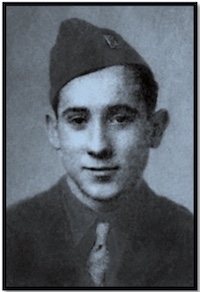
April 28, 2020 - The United States’ entry into the World War was still 13 years away when on March 3, 1904, Luther McNary Beckham, age 23 wed Miss Katie Parker, age 15 in Shelby County, Texas. Luther provided for his family by farming and working in a lumber mill. Their first child, a son Osler was born January 1908 and tragically died five months later. Daughter Lillian Meriam arrived in 1910 followed by son James Luther in 1922. The final two to join the family were daughters Mary Catherine in 1924 and Martha Janice five years later 1929.
By the time their only surviving son James Luther was born at the family home in Garrison, Nacogdoches County, August 3, 1922 the World War was now four years in the past and thankfully father Luther was not called to serve. By 1930 James was old enough to help with chores on the family farm as was the custom of the time.
The first peacetime conscription in the United States was enacted on September 16, 1940. It required all American men between the ages of 21 and 45 to register for the draft. As James was 18, he was exempt. With the Japanese attack on Pearl Harbor, Hawaii December 7, 1941 the United States was now at war and the act now required all men from age 18 to 45 to register. James now 19 married 21 year old Gwendolyn Adair Hooper in Shelby County on February 20, 1942. Three months later June 30, 1942 he registered in Center, the country seat of Shelby County. He was self-employed as a farmer, stood five foot, six inches and weighed 130 pounds. Four months later he was called to serve and was inducted into the US Army in Tyler, Texas.
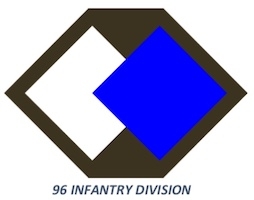 Two months before James was inducted the 96 Infantry Division was ordered to active service, August 15, 1942. He was assigned to the 381 Infantry Regiment that was a sub-component of the 96th. He and other new recruits joined them at Camp Adair, Oregon. After training was complete the “Deadeye” Division moved on to Camp Lewis in Washington state and then to Camp Beale, California. On July 23, 1944 the 96th Division commanded by Major General James L. Bradley left California for the Hawaiian Islands where they trained for an assault landing from time of arrival to September 1944. They entered combat on October 20, 1944 in an assault landing in Leyte, Gulf, Philippine Islands on beaches codenamed Blue and Orange. Enemy resistance was quickly broken and through heavy fighting the Division had secured the island by Christmas Day. It came at a price however as 514 Deadeyes were killed in action or died of wounds and almost 1,500 more were wounded.
Two months before James was inducted the 96 Infantry Division was ordered to active service, August 15, 1942. He was assigned to the 381 Infantry Regiment that was a sub-component of the 96th. He and other new recruits joined them at Camp Adair, Oregon. After training was complete the “Deadeye” Division moved on to Camp Lewis in Washington state and then to Camp Beale, California. On July 23, 1944 the 96th Division commanded by Major General James L. Bradley left California for the Hawaiian Islands where they trained for an assault landing from time of arrival to September 1944. They entered combat on October 20, 1944 in an assault landing in Leyte, Gulf, Philippine Islands on beaches codenamed Blue and Orange. Enemy resistance was quickly broken and through heavy fighting the Division had secured the island by Christmas Day. It came at a price however as 514 Deadeyes were killed in action or died of wounds and almost 1,500 more were wounded.
The Division left the Philippines, March 27, 1945 for Okinawa and made an assault landing on the island April 1, 1945 beginning “Operation Iceberg”, the last major battle in the pacific. The landing was unopposed but as they advanced fighting was fierce. The 96th was relieved by the 77th Infantry Division on April 30 so that they could rest and train. Unfortunately four days prior, Private First Class James Luther Beckham had been killed in action by exploding shell fragments.
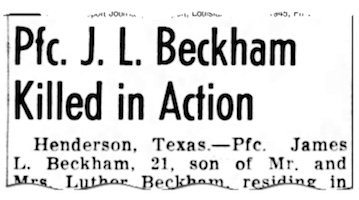 The Timpson Weekly Times dated June 8, 1945 reported that his parents received official word from the War Department that James had been killed in action on April 26, 1945 on Okinawa. His wife Gwendolyn and small daughter Billie Sue were residing in Orange, Texas as this time and received the same notification.
The Timpson Weekly Times dated June 8, 1945 reported that his parents received official word from the War Department that James had been killed in action on April 26, 1945 on Okinawa. His wife Gwendolyn and small daughter Billie Sue were residing in Orange, Texas as this time and received the same notification.
Combat operations on Okinawa came to an end in late June 1945. Army and Marine divisions had set up cemeteries for their fallen comrades and PFC Beckham had been buried in the 96 Division Cemetery No. 1. These cemeteries on Okinawa were meant to be temporary and in December 1945, the War Department began a process to remove and return fallen Americans from battlefields across the world. Permanent American military cemeteries were established on land donated by liberated countries and those in temporary cemeteries were interred in the permanent sites. Some of the next of kin, however, wanted the remains of their loved ones brought back to the United States and either re-buried in their local cemetery or in one of the many national cemeteries (such as Arlington) around the country. Beginning in 1947, a program for the repatriation of bodies was initiated and families were given the choice. James’ family wanted him to come home as did 56% of other families facing the same decision.
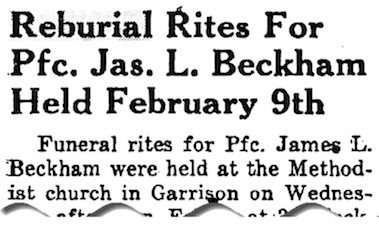
It did not happen overnight as the return of over 171,000 war dead was a massive undertaking. From the port of embarkation at Oakland, California the remains of Private First Class James Beckham arrived in Timpson, Texas on Tuesday, February 8, 1949 and carried to the home of his sister Lillian Meriam Harris near Garrison. Funeral services were held the next day at the Methodist Church in Garrison at 3 p.m. with Rev. W. E. Griffiths and Rev. Lewis A. Wright conducting the services. Reburial was in the Greenwood Cemetery in Garrison with the American Legion Posts of Garrison and Timpson in charge of the graveside service. Rex Brinson of Timpson spoke for the Legionnaires, paying tribute to the life and memory of the deceased. Services were conducted with full military honors. The rifle squad was composed of members of the Timpson military company with First Sergeant Arthur Horton in charge. Taps was sounded by Dannie Sapp and James Webb. His survivors at the time were; wife Gwendolyn; daughter Billie Sue; parents Kate and Luther Beckham; three sisters, Lilliam Meriam Harris, Mary Catherine Seber and Martha Janice Beckham.
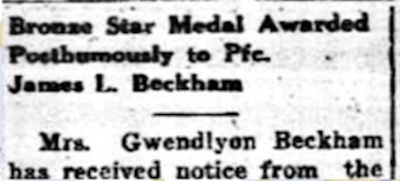
BRONZE STAR MEDAL WITH “V” (VALOR) DEVICE
AWARDED POSTHUMOUSLY TO PRIVATE FIRST CLASS JAMES L. BECKHAM
For heroic service in connection with military operations against the enemy on Leyte Island from 23 October 1944 to 10 February 1945 and on Okinawa Island from 1 April 1945 to 26 April 1945. Private First Class Beckham was often a member of a carrying party which packed supplies as much as fifteen hundred yards over open terrain to the front lines. On return trips over the same rout he acted as litter bearer carrying wounded back to the battalion aid station. The route, frequently being without cover or concealment was often under enemy observation and shelling by enemy artillery and mortars. In spite of these hazards he always got through to the front with vitally needed supplies. On the nights of 12 and 13 April when the battalion had an open sector in the line, he occupied the position along with other men who were also not members of line companies and aided in holding that position, besides his usual duties of battalion intelligence scout which involved dangerous reconnaissance for trail nets, steam systems and enemy activity on an almost impossible terrain, through inclement weather and under much heavy enemy fire. Private First class Beckham’s long period of outstanding service and devotion to duty continued until he was fatally wounded and reflects lasting credit to himself and the military service.”
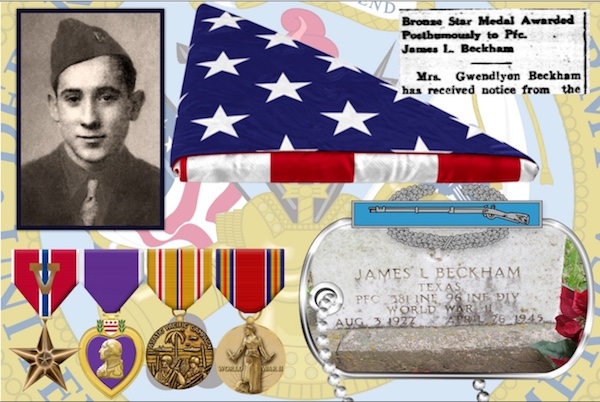
Sources: Ancestry.com; Find A Grave Memorial 43072279; Fold3.com; Texas history.unt.edu (Timpson Newspaper Archives; Historynet.com/last-train-home; WW2online.org; history.arm.mil.









